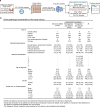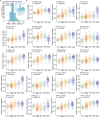Artificial intelligence defines protein-based classification of thyroid nodules
- PMID: 36068205
- PMCID: PMC9448820
- DOI: 10.1038/s41421-022-00442-x
Artificial intelligence defines protein-based classification of thyroid nodules
Erratum in
-
Author Correction: Artificial intelligence defines protein-based classification of thyroid nodules.Cell Discov. 2022 Sep 30;8(1):100. doi: 10.1038/s41421-022-00471-6. Cell Discov. 2022. PMID: 36180436 Free PMC article. No abstract available.
Abstract
Determination of malignancy in thyroid nodules remains a major diagnostic challenge. Here we report the feasibility and clinical utility of developing an AI-defined protein-based biomarker panel for diagnostic classification of thyroid nodules: based initially on formalin-fixed paraffin-embedded (FFPE), and further refined for fine-needle aspiration (FNA) tissue specimens of minute amounts which pose technical challenges for other methods. We first developed a neural network model of 19 protein biomarkers based on the proteomes of 1724 FFPE thyroid tissue samples from a retrospective cohort. This classifier achieved over 91% accuracy in the discovery set for classifying malignant thyroid nodules. The classifier was externally validated by blinded analyses in a retrospective cohort of 288 nodules (89% accuracy; FFPE) and a prospective cohort of 294 FNA biopsies (85% accuracy) from twelve independent clinical centers. This study shows that integrating high-throughput proteomics and AI technology in multi-center retrospective and prospective clinical cohorts facilitates precise disease diagnosis which is otherwise difficult to achieve by other methods.
© 2022. The Author(s).
Conflict of interest statement
The research group of T.G. is supported by Pressure Biosciences Inc., which provides sample preparation instrumentation. T.G. and Y. Zhu are shareholders of Westlake Omics Inc. W.L., G.R., Q.Z., H.C., Y. Hu and W.G. are employees of Westlake Omics Inc. R.A. holds shares in Biognosys, a proteomics company operating in the field of research. The remaining authors declare no competing interests.
Figures





References
-
- Burman KD, Wartofsky L. Clinical practice. Thyroid nodules. N. Engl. J. Med. 2015;373:2347–2356. - PubMed
-
- Jameson JL. Minimizing unnecessary surgery for thyroid nodules. N. Engl. J. Med. 2012;367:765–767. - PubMed
-
- Faquin WC, Bongiovanni M, Sadow PM. Update in thyroid fine needle aspiration. Endocr. Pathol. 2011;22:178–183. - PubMed
-
- Alexander EK, et al. Preoperative diagnosis of benign thyroid nodules with indeterminate cytology. N. Engl. J. Med. 2012;367:705–715. - PubMed
-
- Ahn HS, Kim HJ, Welch HG. Korea’s thyroid-cancer “epidemic”—screening and overdiagnosis. N. Engl. J. Med. 2014;371:1765–1767. - PubMed
Grants and funding
LinkOut - more resources
Full Text Sources
Other Literature Sources

